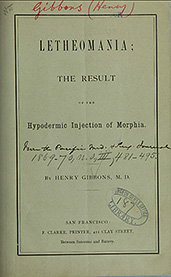-
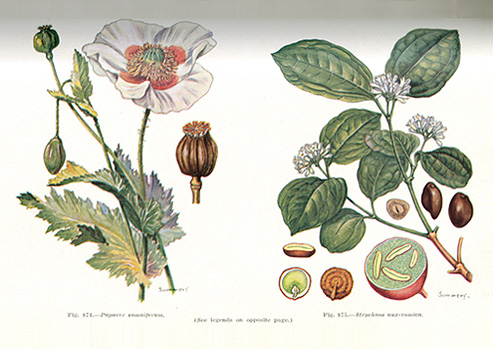
Fig. 874—Papaver somniferum in Dennis Emerson Jackson, Experimental Pharmacology and Materia Medica, 1939
Courtesy National Library of Medicine
 BOTANICAL, Papaver somniferum
BOTANICAL, Papaver somniferumAs pharmacology professor Dr. Dennis Jackson noted in his guide to medicinal drugs, the pain-relieving properties of opium had been known for centuries. In America, the drug was first used for the treatment of sleeplessness and illnesses such as coughs, smallpox, cholera, malaria, syphilis, dysentery, and tuberculosis.
Fig. 874- Papaver somniferum (see legends on opposite page) Fig. 875.- Strychnos nux-vomica
-
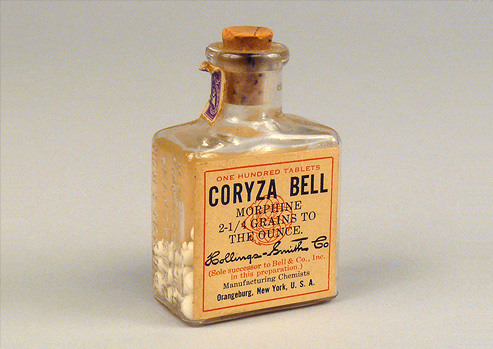
Coryza Bell morphine tablets, Hollings-Smith Co.
Courtesy National Museum of American History
 CURATIVE, Pain Relief
CURATIVE, Pain ReliefMorphine was isolated from opium in 1805, and American physicians began widely prescribing the drug in the 1860s, distributing pills and powders among Civil War soldiers and veterans, and injecting middle and upper-class women for the treatment of so-called “female troubles” such as nervousness and lethargy.
CORYZA BELL
MORPHINE 2–1/4 GRAINS TO THE OUNCE.
Hollings-Smith Co
(Sole successor to Bell & Co., Inc. in this preparation.)
Manufacturing Chemists
Orangeburg, New York, U.S.A -
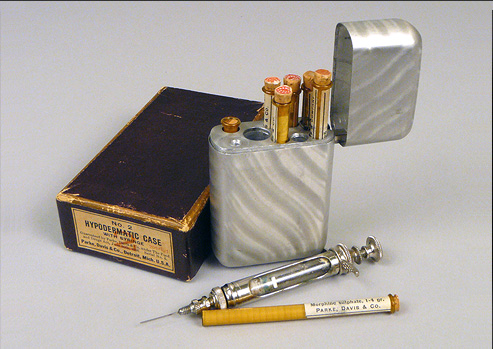
Physician’s hypodermic needle kit with morphine, Parke, Davis & Co., 1908–1918
Courtesy National Museum of American History
 CURATIVE, Pain Relief
CURATIVE, Pain ReliefMorphine was isolated from opium in 1805, and American physicians began widely prescribing the drug in the 1860s, distributing pills and powders among Civil War soldiers and veterans, and injecting middle and upper-class women for the treatment of so-called “female troubles” such as nervousness and lethargy.
No. 2
HYPODERMATIC CASE WITH SYRINGE
PARKE, DAVIS & CO., Detroit, Mich. U.S.A
NITROGLYCERIN AND STRYCHNINE
-
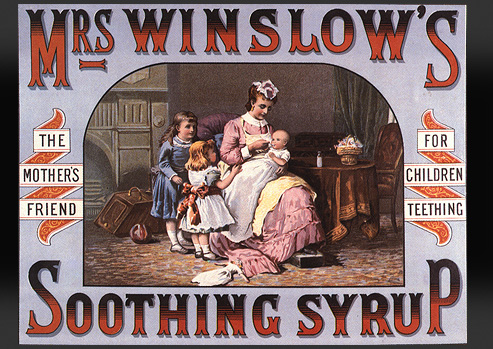
Advertisement for a children's remedy containing morphine for the pain of teething, ca. 1880
Courtesy National Library of Medicine
 MARKET, “Miracle Cure”
MARKET, “Miracle Cure”By 1905, Americans were spending millions of dollars on patent medicines that promised miracle cures. The often secret ingredients of those supposed remedies included cocaine, opium, and alcohol. Mrs. Winslow’s Soothing Syrup contained morphine and was marketed to mothers to help soothe their babies discomfort when teething.
MRS WINSLOW’S SOOTHING SYRUP
THE MOTHER’S FRIEND FOR CHILDREN TEETHING -
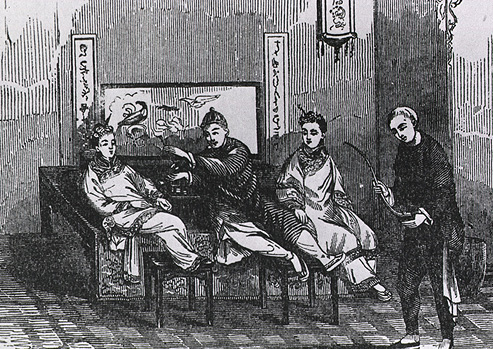
Opium smoking party, 1882
Courtesy National Library of Medicine
 CONSUMER, Smoking Dens
CONSUMER, Smoking DensIn the 1870s, Chinese immigrants introduced opium smoking to American cities, and the habit spread to the urban underclass. Unlike consumers of patent medicines, who could indulge discreetly in private, smokers relied on opium dens for the purchase and pipe-smoking of warmed opium pills.
-
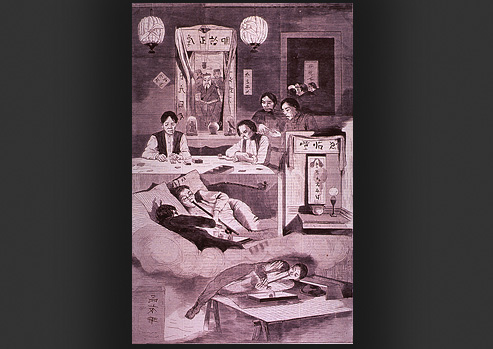
Winslow Homer, “The Chinese in New York—scene in a Baxter Street Club-House,” Harpers Weekly, 1874
Courtesy National Library of Medicine
 CONSUMER, Smoking Dens
CONSUMER, Smoking DensIn the 1870s, Chinese immigrants introduced opium smoking to American cities, and the habit spread to the urban underclass. Unlike consumers of patent medicines, who could indulge discreetly in private, smokers relied on opium dens for the purchase and pipe-smoking of warmed opium pills.
-
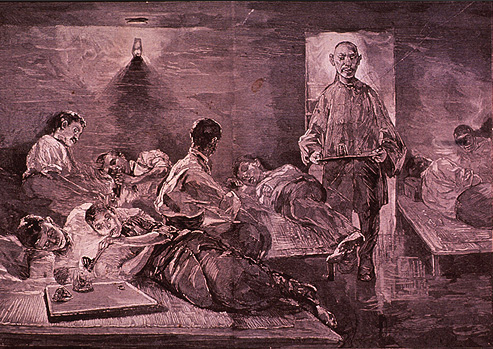
J. W. Alexander, “American Opium-Smokers: Interior of a New York Opium Den,” Harpers Weekly, 1881
Courtesy National Library of Medicine
 CONSUMER, Smoking Dens
CONSUMER, Smoking DensIn the 1870s, Chinese immigrants introduced opium smoking to American cities, and the habit spread to the urban underclass. Unlike consumers of patent medicines, who could indulge discreetly in private, smokers relied on opium dens for the purchase and pipe-smoking of warmed opium pills.
-
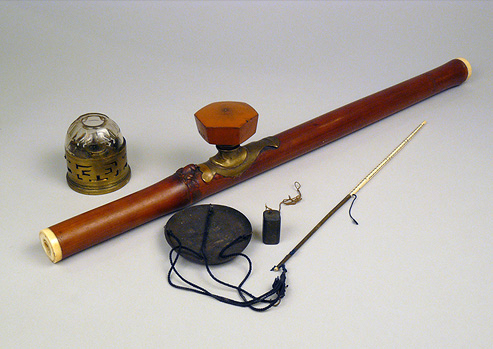
Opium lamp, pipe and bowl for smoking opium, the technique preferred by Chinese immigrants, and a scale used for weighing the drug
Courtesy National Museum of American History
 CONSUMER, Smoking Dens
CONSUMER, Smoking DensIn the 1870s, Chinese immigrants introduced opium smoking to American cities, and the habit spread to the urban underclass. Unlike consumers of patent medicines, who could indulge discreetly in private, smokers relied on opium dens for the purchase and pipe-smoking of warmed opium pills.
-
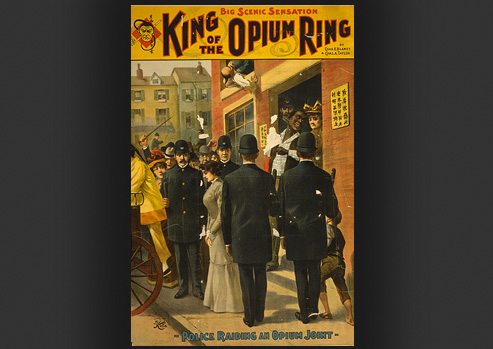
Advertisement for King of the Opium Ring, showing raid on an “opium den,” 1899
Courtesy Library of Congress
 PROHIBITIVE, Chinatown Raid
PROHIBITIVE, Chinatown RaidAs panic about the drug’s effects rose, reformers argued that opium addiction was rapidly increasing. Yet, usage had begun to decline at the turn of the 20th century. Reformers singled out the Chinese and lobbied for new laws and police raids to crack down on “opium dens” in Chinatown districts.
KING OF THE OPIUM RING
BIG SCENIC SENSATION
BY CHAS. E. BLANEY & CHAS. A. TAYLOR.
—POLICE RAIDING AN OPIUM JOINT—
The pain-relieving properties of opium had been known for centuries when the drug was first used in America for the treatment of sleeplessness and illnesses such as coughs, smallpox, cholera, malaria, syphilis, dysentery, and tuberculosis. By the 19th century, many doctors believed so fervently in the benefits of opium use that that they personally indulged in the habit. The enthusiasm for medical treatments created many addicts among doctors and their patients, yet reformers’ efforts to restrict opium use focused on Chinese immigrants and the practice of opium smoking that they had introduced to America.


